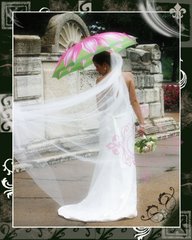
In the past 4 years we have not seen a single wedding gown made by the bride (or anyone else for that matter)! When dinosaurs roamed the earth, I made my own gown. It was from a Vogue pattern and I cut it out on the floor of the commons room in my college dorm. It was an empire waist, square neck gown with 4 tiers with a wide lace trim and a moderate train. The fabric was ivory peau de soie and I hand pearled the lace in every spare moment as well as over Thanksgiving break. Yes, we celebrated Thanksgiving in the Stone Age! :) That gown was absolutely stunning! It has long since been used for other projects, the fabric salvaged for Christening Gowns, or other bridal accessories over the years, but the memory of creating it, and wearing it remains. But for whatever reason, making wedding gowns has fallen out of favor, at least for our brides. We have seen a few handmade veils, and for the most part, they have been lovely. Below are some tips if you have ever given it any thought! While veils are not terribly expensive, a really great one with some customized touches can run high. Let us know if you give it a try! It really isn't difficult!Vogue, Burda, Butterick, McCalls, and Simplicity all produce good basic bridal veil patterns, many of which also include directions for some sort of headpiece. They generally cost $8-$15 (Wal-Mart and most large fabric chains sell patterns at half price), contain all the instructions, list exactly what's needed and how much of it, and the tissue provides a foolproof cutting guide.
However, if you feel adventurous, or have some sewing experience and just need a few specific pointers, here are some basic instructions for making two types of veils. Recommended tools and supplies are:
scissors (sharp dressmaking shears are best) or a rotary cutter and cutting mat- small weights for laying out the tulle (canned goods or smooth stones work)
- a tape measure and/or yardstick
- pins and needle
- thread to match the tulle
- An iron is useful but not necessary.
- Depending on the style of veil you want, you may also need:
comb, Velcro, or bridal loops (sold by the yard at fabric stores) satin rattail cord, soutache, pearl cotton, or other edging small pearls, sequins, crystals, or other decoration fabric glue, tweezers, and toothpicks for attaching decoration - The amount of tulle you need will vary according to style and height. The traditional lengths (adjust for your individual height and taste) are:
Shoulder or blusher, 18"-24" - Waist, 30"
- Fingertip, 40"
- Chapel or floor, 60"-72"
- Cathedral, 108" or longer
I recommend buying 108" width tulle for fingertip and longer veils. Most fabric and craft stores carry it. 72" width works well for the shorter lengths unless you want a very full look.
Tulle, or bridal illusion, is sold in white, diamond white, and ivory shades. Dye lots vary, so be sure to buy all you need at one time, from the same bolt. If one store doesn't have the right color, another shop may have a bolt that matches nicely. White is best for synthetic gowns. Diamond white looks best with silk or off-white gowns. An ivory gown may look good with either diamond white or ivory tulle, so buy a foot or so to try out. You may also be able to find candlelight tulle, which has a warmer, pinker cast. A range of colors is available at most fabric stores but the wider widths may be limited to a few basic shades.
Organza and chiffon make pretty veils as well. However, unlike tulle, the raw edges of these fabrics must be finished or they will ravel and fray. A narrow rolled edge works well, and an edge bound with a wide bias strip of satin or self fabric is streamlined and elegant. Organza and chiffon are commonly sold in 45" and 60" widths. 72" width is sometimes available in a limited range of colors.
Veil Edge Finishes: You can leave the edge raw for a wispy look or you can finish it off. A pencil edge, a corded edge, ribbon, lace...there are many possibilities. A serger is not necessary for a fine pencil edge; in fact I personally find the serged edge tends to look cheap and unprofessional. Here are two methods for a narrow edging using a regular sewing machine.
A rolled edge can be made by folding over the edge about 1/2" and zigzagging over the fold. Use a fine thread, like a serger thread or size 80 to 120 cotton thread, and a closely spaced, narrow zigzag. Trim away the excess tulle very close to the stitches, being careful not to nick them. Applique scissors are good for this.
For a ruffled 'lettuce edge' effect, stretch the tulle slightly while stitching; experiment with scraps to see how much you need to stretch it, then keep that tension constant for the best look.
Special Edges:
A corded edge can be made by zigzagging over a length of pearl cotton, bourdon gimp, or satin rattail or mousetail cord. Lay the cord about 1/2" from the edge and set the stitch just wide enough to enclose it. After stitching, trim as close to the stitches as possible.
Soutache braid or ribbon can be sewn on in a manner similar to the cord, using a straight stitch rather than a zigzag. It is usually easier to sew an edging 1/2" or so from the edge and trim the excess tulle than to try to align it perfectly with the cut edge.
art & instructions credit: Jennifer Haley












No comments:
Post a Comment